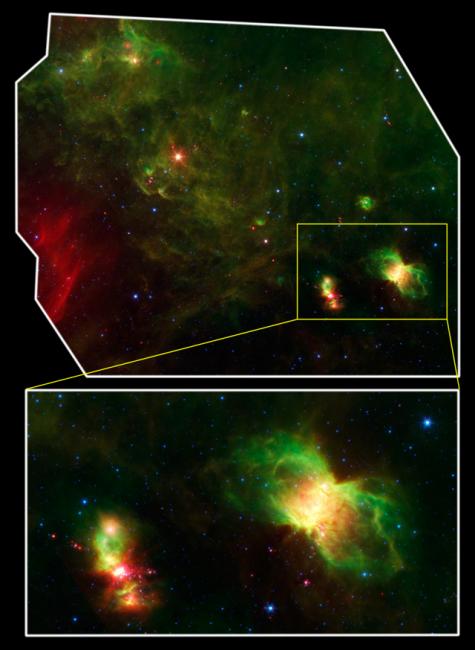
A Spitzer Space Telescope infrared image of the Vela Molecular Cloud D.
Hundreds of young, infrared bright stars are seen embedded in the dusty wisps, filaments, and other structures in which they formed. The broad range of colors represent the diversity of temperatures and processes underway in Vela as new stars form; the inset shows details around two sources in Vela.
The Vela Molecular complex is a set of giant clouds of gas and dust that are not particularly well known to North Americans because they are in the direction of the southern hemisphere constellation of Vela, "The Sails of Argus." Like other giant clouds in our galaxy, Orion for example, the Vela clouds contain millions of solar-masses of of gas and dust. The material in these clouds is gravitationally bound together, and gradually tends coalesce to produce stars of many different types.
What is unusual and important about the Vela molecular clouds is that they lie in the outer portion of our galaxy, about two thousand light-years further away from the central region than the sun and its planets. If the processes of star formation differ in the outer regions of our galaxy from the inner parts, perhaps because of differences in the abundances of the elements, then Vela might reveal it. Astronomers studying Vela are also freed from the need to sort out the background clutter of other stars that are more prevalent when looking inward.
A team of Italian astronomers has been working for nearly a decade to unravel the secrets of the Vela molecular clouds. They recently teamed up with SAO astronomers Massimo Marengo, Lori Allen, Giovanni Fazio, and Howard Smith to use the powerful infrared imaging capabilities of the Spitzer Space Telescope. They concentrated on one group of four adjacent clouds in Vela, and examined it for evidence of young stars in the early stages of formation, perhaps only a few hundred thousand years old; for comparison, the sun is about 4.5 billion years old. The magnificent new images reveal 850 extremely infrared sources scattered throughout the clouds. Most of them are stellar juveniles probably millions of years old, several dozens of them appear to be only hundreds of thousand of years old, and five have no stellar core at all. These coreless objects, they speculate, might be very early, pre-stellar clumps of kinds that have been predicted. Overall, the team uncovered an unusually high number of coreless clumps and very young stars, and they speculate that it might be due to something unusual about the Vela environment.
Although additional research is needed to corroborate and elucidate these conclusions, the new results confirm that star formation in the outer part of our galaxy takes place in ways that differ from the inner regions. Our sun, lying as it does in a mid-zone of the galaxy approximately between the inner and outer regions, might itself have formed from some blend of conditions. The new research on Vela adds an important piece of evidence to the picture of stellar birth throughout the galaxy.